Overview
This article offers essential insights into the VA rating for headaches among veterans, acknowledging the challenges you may face in the application process. We understand that navigating this journey can be overwhelming, but there are effective ways to manage it. By highlighting the importance of thorough documentation and a clear understanding of the VA's rating criteria, we aim to empower you. This knowledge can significantly enhance your chances of receiving the benefits you deserve for headaches.
We provide detailed steps and resources to support your claims, ensuring you feel confident in your approach. Remember, you are not alone in this journey; we’re here to help you every step of the way. Together, we can work towards achieving the benefits that can improve your quality of life.
Introduction
Navigating the complexities of VA headache ratings can feel overwhelming for veterans seeking the benefits they truly deserve. We understand that the application process is intricate, and the criteria for conditions like migraines and tension headaches can vary significantly. It's crucial to know how to present your case effectively.
This article offers essential insights aimed at empowering veterans to enhance their claims, streamline their applications, and ultimately secure the compensation they need.
What challenges might you face on this journey? How can you overcome them to ensure your voice is heard in the VA system? Remember, you are not alone in this process, and we’re here to help.
Turnout: Streamlining VA Headache Rating Applications
Navigating the headaches VA rating application process can be overwhelming for former service members. At Turnout, we harness cutting-edge technology to simplify this journey. By employing AI, we help you easily maneuver through the often convoluted and bureaucratic landscape of benefits.
Our platform provides clear instructions on necessary paperwork and eligibility standards, allowing you to submit your requests both efficiently and effectively. This innovative approach significantly reduces the time and stress usually linked with traditional methods, enabling you to focus on your health and well-being. With our trained advocates and IRS-licensed enrolled agents, you can rest assured that the complexities of your case are expertly managed.
It's common to feel anxious about the process, especially when you consider that the VA automates over 1,000 Dependency and Indemnity Compensation (DIC) payments each day. With a remarkable ninefold rise in processing efficiency, AI technology is reshaping the experience for service members like you. As a result, the average time to complete disability-related claims has decreased to just 94.8 days. This showcases the positive impact of automation on your access to essential benefits.
Remember, you are not alone in this journey. We're here to help you every step of the way.
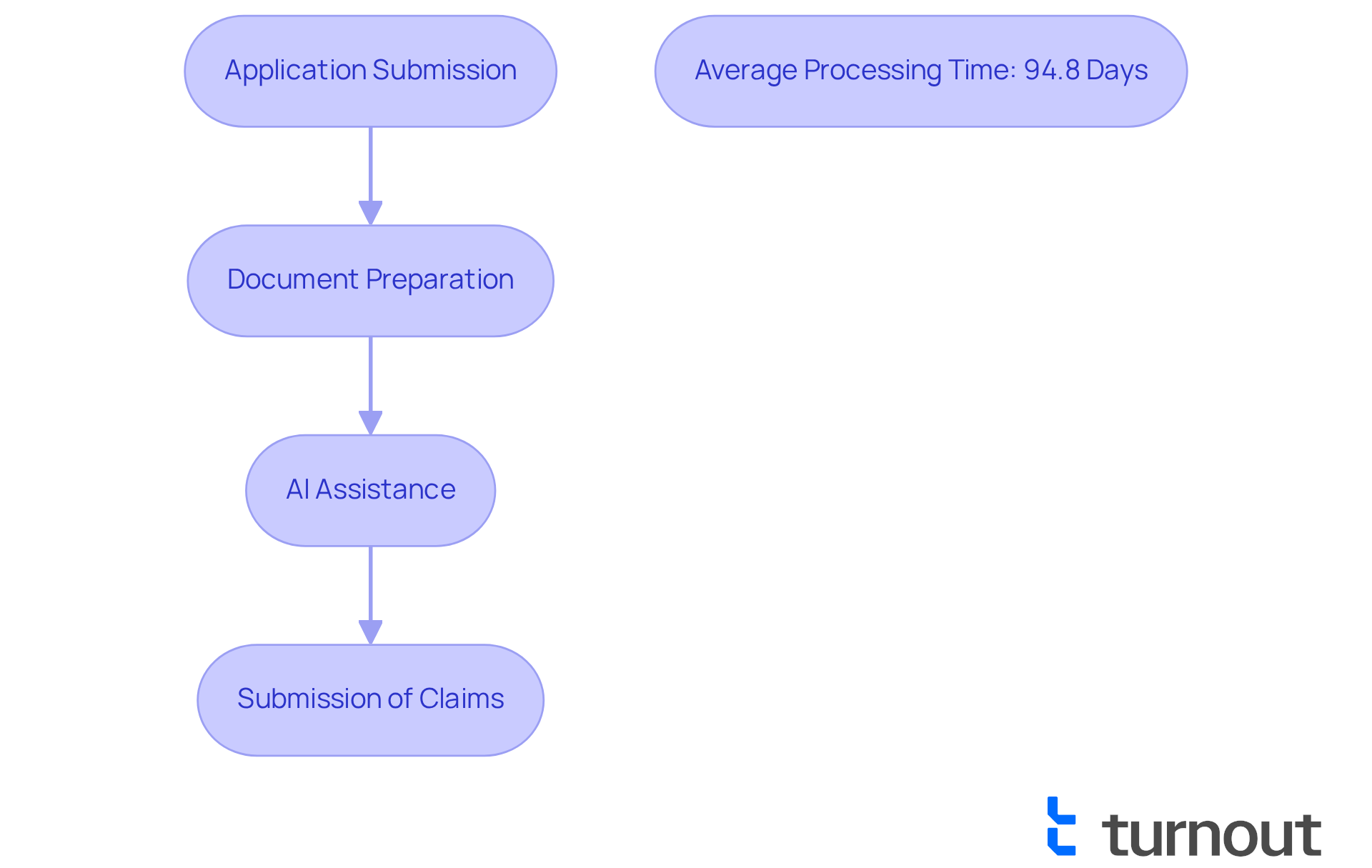
VA Rating Criteria for Migraine and Tension Headaches
We understand that navigating the VA's criteria for assessing migraines and tension-related conditions can be challenging. It's important to know that the headaches VA rating for migraines may be at 0%, 10%, 30%, 50%, or even 100%, depending on how frequently and severely they occur. Tension-related discomforts are typically assessed at 0% or 10%.
By comprehending these criteria, you can better express your symptoms and medical history in a way that aligns with the VA's requirements. This understanding can significantly enhance your chances of receiving a favorable rating. Remember, you are not alone in this journey; we’re here to help you every step of the way.
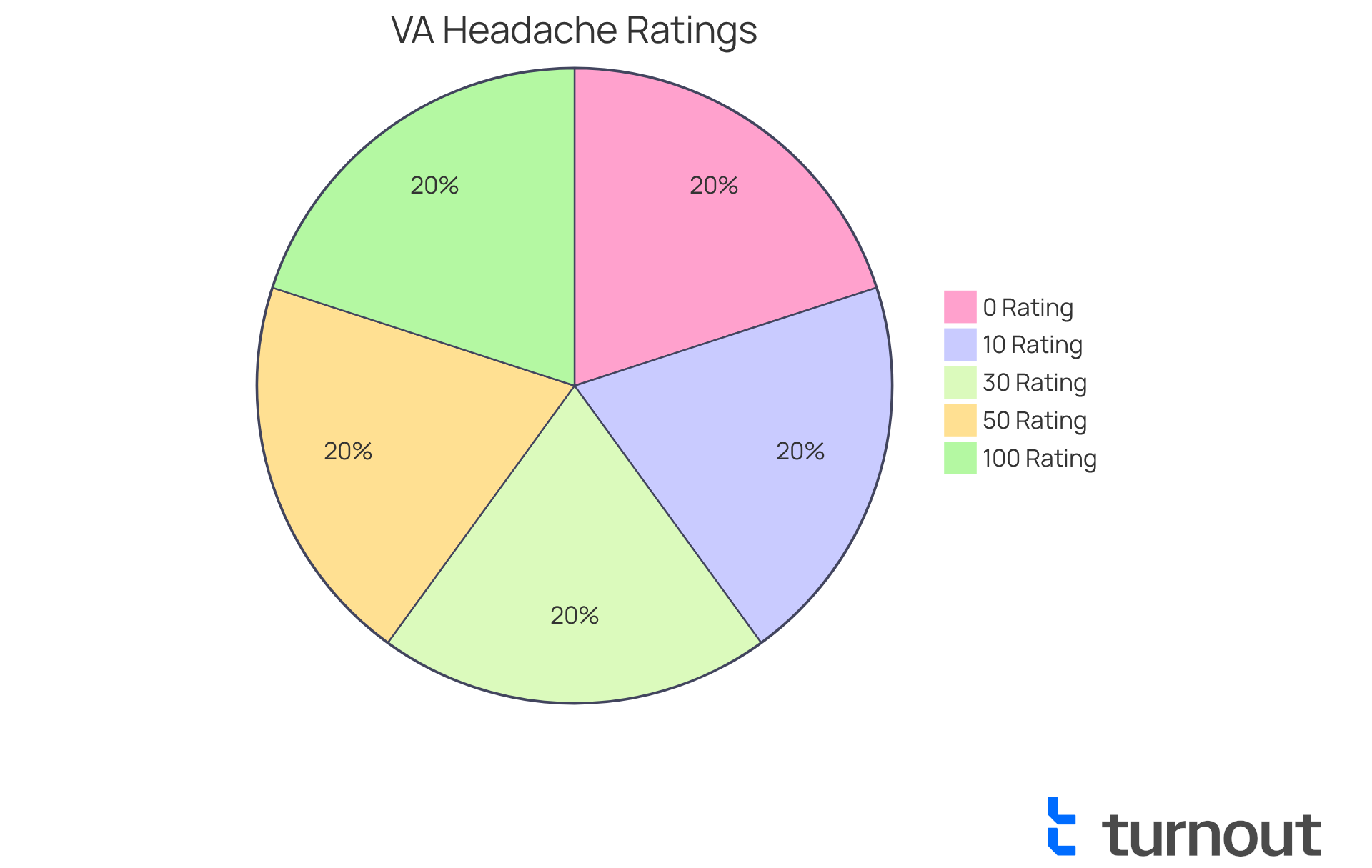
Establishing Service Connection for Headaches: Key Steps
If you are a veteran experiencing [headaches VA rating](https://myturnout.com/meet-jake), know that you are not alone in this journey. To create a support link for your condition, please follow these essential steps:
- Start by collecting thorough medical documentation that details the frequency, intensity, and impact of migraines on your daily life. This includes medical records, symptom logs, and credible statements from healthcare providers. As Brian Reese emphasizes, "Medical evidence is a crucial piece of the puzzle that VA raters consider when reviewing a disability claim."
- Next, acquire records that may suggest exposure to circumstances that could lead to discomfort, such as noted head injuries or environmental factors like burn pits.
- Finally, submit a comprehensive personal statement detailing how your military service contributed to your discomfort. Include specific incidents or stressors you encountered during your service.
This thorough approach not only strengthens your claim but also aligns with the VA's focus on the overall occurrence and financial impact of headaches VA rating.
The average headaches VA rating for migraines typically stands at 30%. However, if you experience very frequent completely prostrating attacks that result in severe economic inadaptability, you may qualify for a headaches VA rating of 50%. Many veterans have successfully navigated this process by meticulously documenting their symptoms and experiences. This diligence has proven essential in securing the benefits you deserve. Remember, we’re here to help you every step of the way.
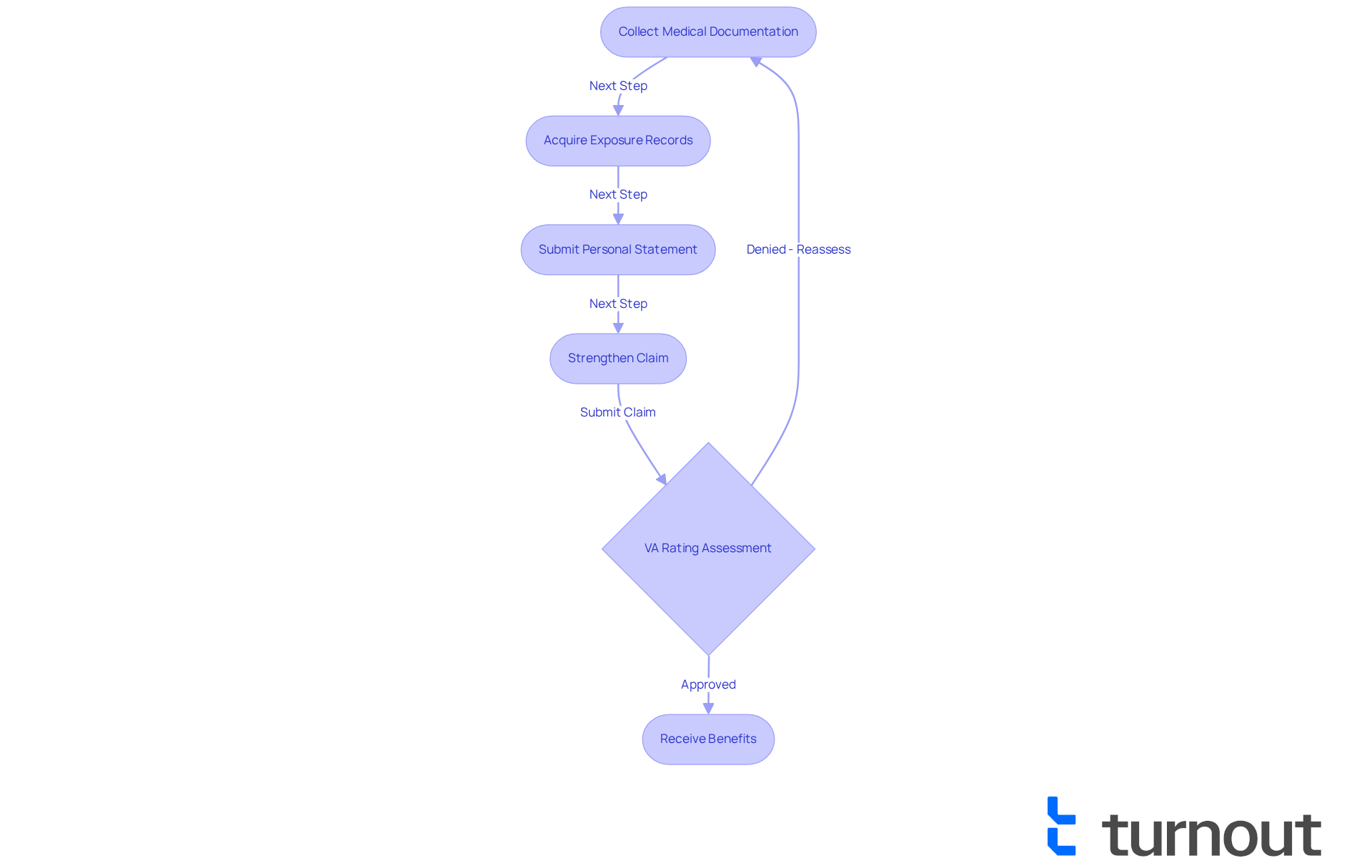
Understanding 'Prostrating' Migraines in VA Ratings
Prostrating migraines can be incredibly debilitating, often leaving individuals unable to carry out their daily activities. We understand that these severe headaches can significantly impact your life. The VA evaluates these migraines based on their frequency and duration when determining headaches VA rating, which can range from 0% to 50%. It's crucial for veterans to meticulously document how often these migraines occur and how they affect your ability to work and socialize. This documentation is essential for supporting your claims.
Medical professionals emphasize the serious economic challenges that migraines can create. One expert noted, 'If your migraine symptoms leave you hiding in a dark room from the pain, it may qualify as a prostrating migraine under the headaches VA rating system.' Moreover, studies indicate that approximately 5.3% of former military personnel experience chronic migraine symptoms. This underscores the importance of comprehensive documentation to support your claims for disability benefits.
As you navigate this journey, consider obtaining a nexus letter to establish a connection between your migraines and military service. By keeping a detailed journal of your migraine episodes, you can strengthen your application and improve your chances of receiving the compensation you deserve.
We’re here to help. Turnout offers valuable tools and services, including personalized guidance and resources, to assist former service members in navigating the complexities of SSD claims. You are not alone in this journey; we aim to ensure you receive the financial support you deserve without the need for legal representation.
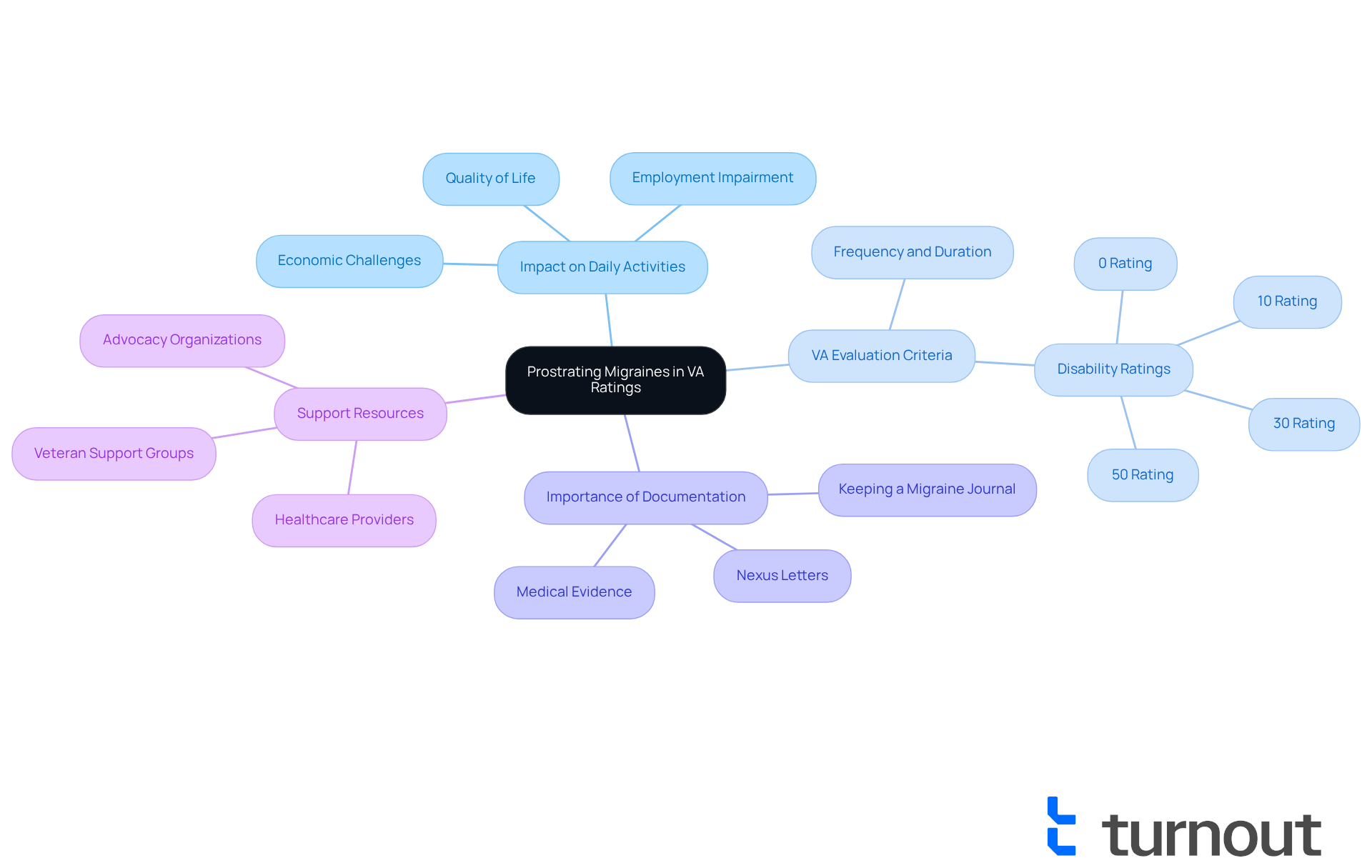
TDIU Eligibility for Veterans with Headaches
If you are a veteran experiencing pain that makes it difficult to maintain productive work, you may be eligible for Total Disability Individual Unemployability (TDIU). We understand how challenging this situation can be. To qualify for TDIU, former military personnel must demonstrate that their headaches VA rating significantly hinder their ability to work. This often involves providing medical evidence and personal statements that illustrate how your condition affects your daily life.
TDIU can provide service members with compensation at the 100% disability rate, even if their combined headaches VA rating is below 100%. You are not alone in this journey; we’re here to help you navigate the process and ensure you receive the support you deserve.
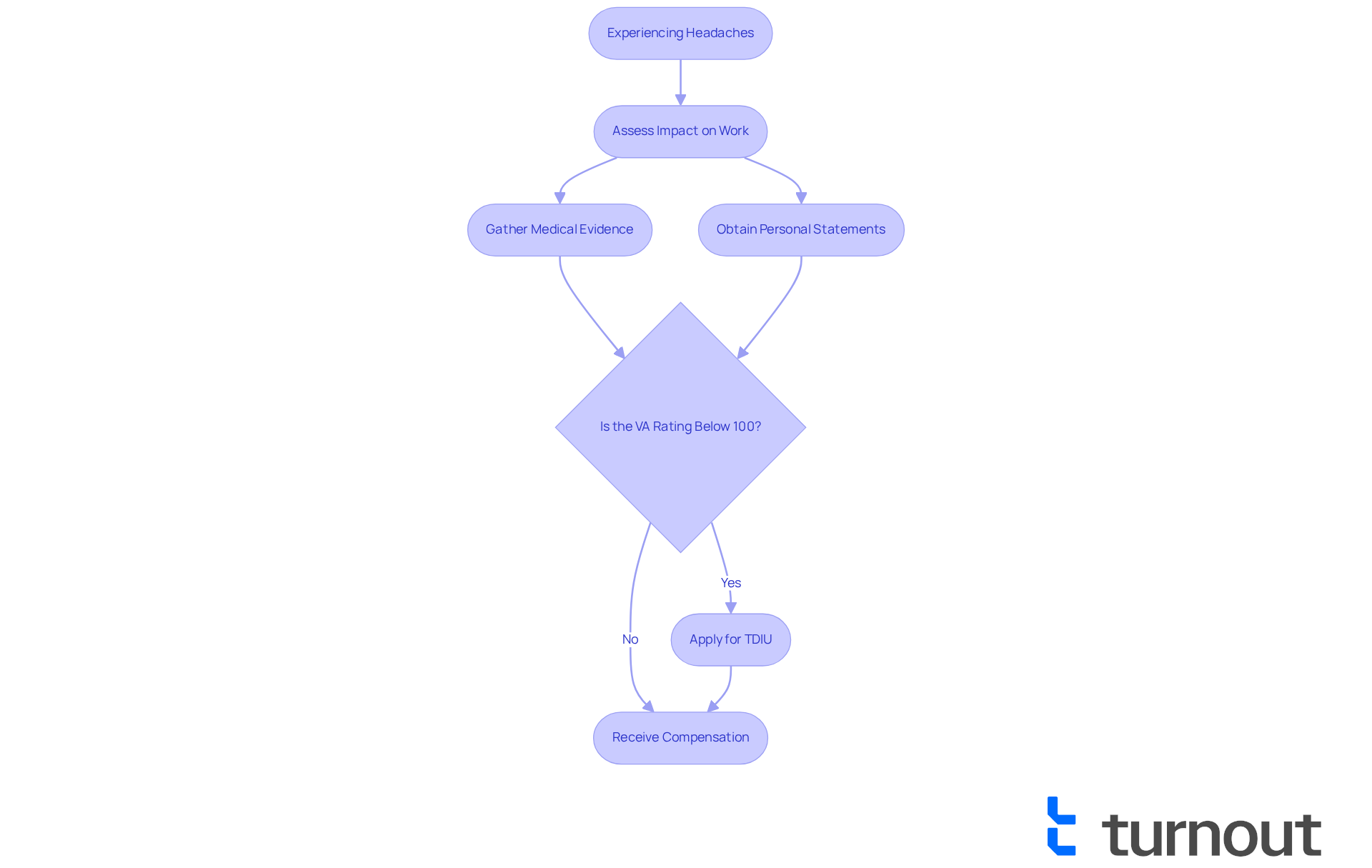
Strengthening Your VA Claim for Headaches
If you're a veteran struggling with headaches VA rating, we understand how challenging this can be. To improve your VA request, consider following these supportive steps:
- Gather thorough medical documentation that records the diagnosis and treatment of your migraines. This evidence is essential for establishing a service connection.
- Keep a comprehensive diary to monitor the frequency, duration, and intensity of your episodes. Data shows that consistent logging over 30 to 90 days can significantly strengthen your assertion by demonstrating a recurring issue.
- Collect statements from relatives or acquaintances who can confirm how migraines affect your everyday life. Their insights will offer valuable context to your claim.
- Ensure all forms are completed accurately and submitted on time. Timely submissions can prevent unnecessary delays in your process.
As Brian Reese, a VA disability benefits expert, emphasizes, "Pain journals or mobile tracking applications may be regarded as credible lay testimony for pain frequency and occupational impairment."
By following these steps, you can greatly enhance your likelihood of a favorable outcome for VA disability benefits concerning headaches VA rating. Remember, you're not alone in this journey; we're here to help you navigate through it.
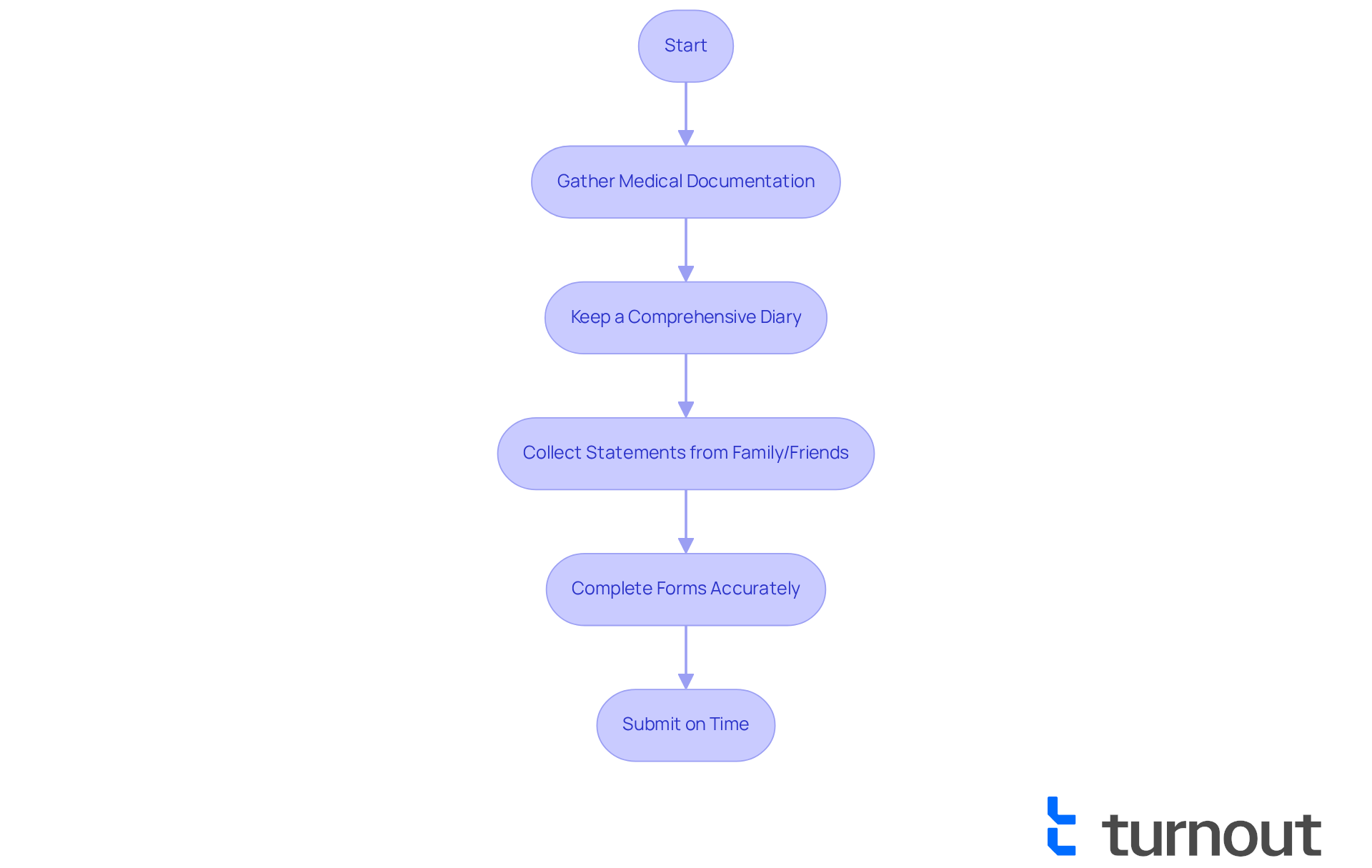
Compensation & Pension Exams: What Veterans Should Know
During a Compensation & Pension (C&P) examination, veterans will be assessed by a medical expert to evaluate the intensity of their pain. These exams typically last between 30 to 60 minutes, providing ample time for a thorough evaluation. We understand that discussing your symptoms can feel daunting; however, it's important to elaborate in detail, including how often you experience pain in your head and its impact on your daily life. Being honest and thorough in your responses is crucial, as this information directly influences your assigned disability rating. Remember, participating in scheduled C&P exams is vital; neglecting to do so could result in the denial of your request.
To effectively prepare for the C&P exam, we encourage veterans to collect pertinent medical records, including past diagnoses and treatments. Keeping a comprehensive diary noting the duration, intensity, triggers, and relief methods for your pain can be incredibly beneficial. This diary can provide valuable insights into the frequency and severity of your episodes, significantly supporting your claims. For instance, incorporating details about how often you feel discomfort and its effect on your daily activities can be advantageous.
You can expect to respond to inquiries regarding your diagnosis related to headaches VA rating, which includes the type and features of your pain, along with any accompanying symptoms like nausea or sensitivity to light. Medical professionals may also ask how migraines impact your ability to carry out daily tasks and sustain employment. The VA provides headaches VA rating under 38 CFR § 4.124a, with ratings ranging from 0% to 50% based on the frequency and severity of attacks.
Effective preparation includes:
- Reviewing military records for any service-related events associated with discomfort.
- Consulting with healthcare providers for additional insights.
- Becoming acquainted with the Disability Benefits Questionnaire (DBQ) related to migraines to help you understand the kinds of inquiries you might face during the assessment.
By being well-prepared and informed, you can improve your chances of obtaining a positive result in your requests. Remember, you are not alone in this journey; we’re here to help.
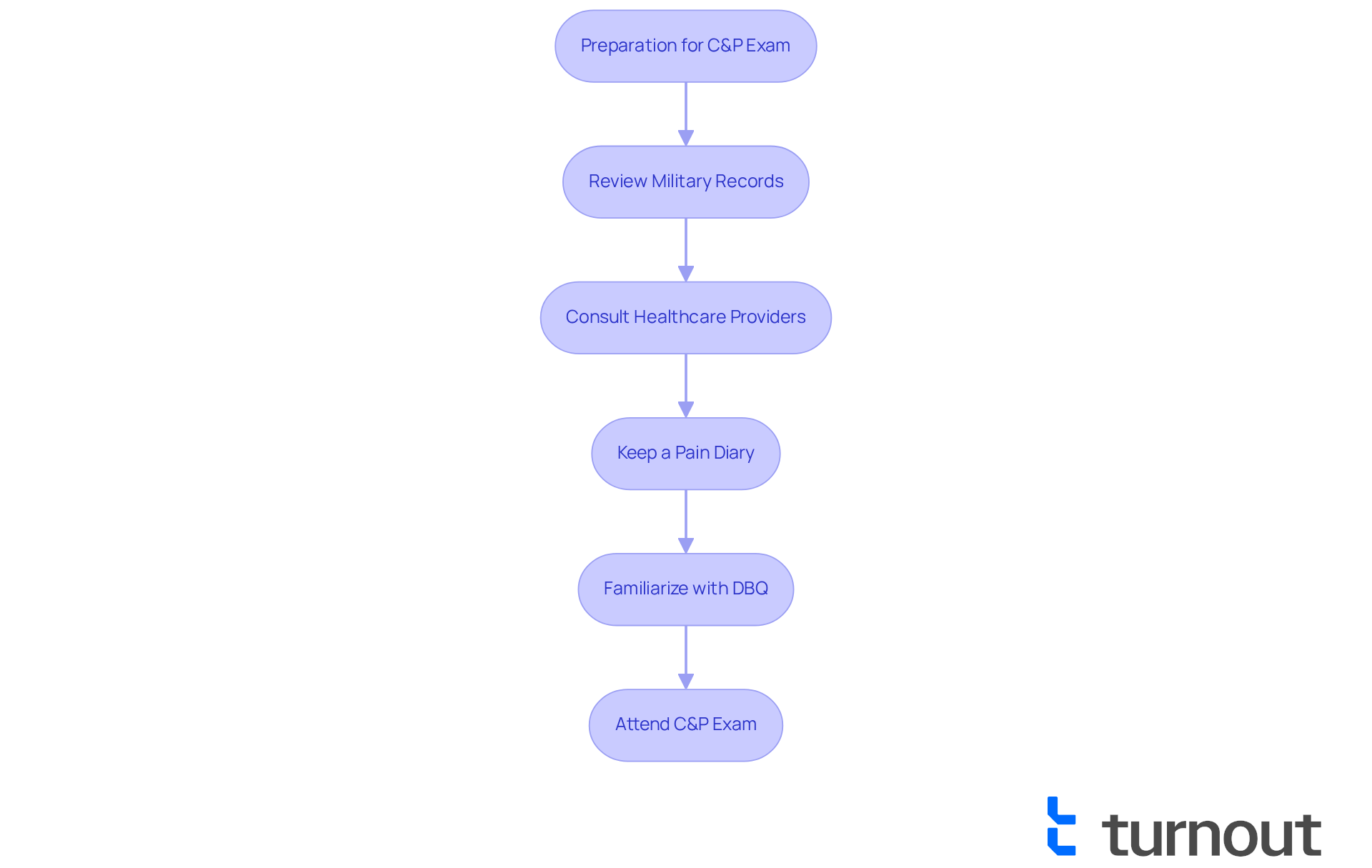
Common Challenges in VA Headache Benefit Claims
Veterans often face significant challenges when filing claims for headache benefits. We understand that navigating this process can be overwhelming, and it’s important to address these concerns with compassion and clarity.
- Insufficient Medical Evidence: Many requests are turned down due to a lack of comprehensive medical records linking the headache condition to military service. In fact, a considerable percentage of claims are denied for this reason, underscoring the necessity of thorough documentation. It's common to feel frustrated when evidence is lacking, but gathering complete medical records can make a difference.
- Establishing Service Link: Proving that migraines are connected to military duty can be a daunting task. This connection is crucial for approval, and we encourage veterans to collect evidence from their medical history and any relevant incidents during their service. A medical nexus opinion indicating at least a 50% likelihood of connection is essential.
The rating criteria for headaches VA rating can be complex and confusing. Many veterans may not fully understand how their symptoms align with the definitions of 'prostrating' attacks, which are vital for their headaches VA rating. Recognizing that 'prostration' refers to being entirely reclined, understanding these criteria can significantly impact the outcome of claims.
- Holds in Managing Requests: The request process can often feel slow, leading to frustration among veterans. Delays frequently arise from the need for additional examinations or documentation, prolonging the time it takes to receive a decision. Research indicates that many claims are rejected due to insufficient medical proof linking the headache condition to military service.
By acknowledging these challenges, former service members can take proactive steps to improve their chances of success. Gathering thorough documentation, including medical records and personal statements, is vital. Furthermore, seeking assistance from advocacy groups can provide meaningful support during the benefits process. Remember, navigating the VA system can feel overwhelming, but with the right help, it becomes manageable. You are not alone in this journey.
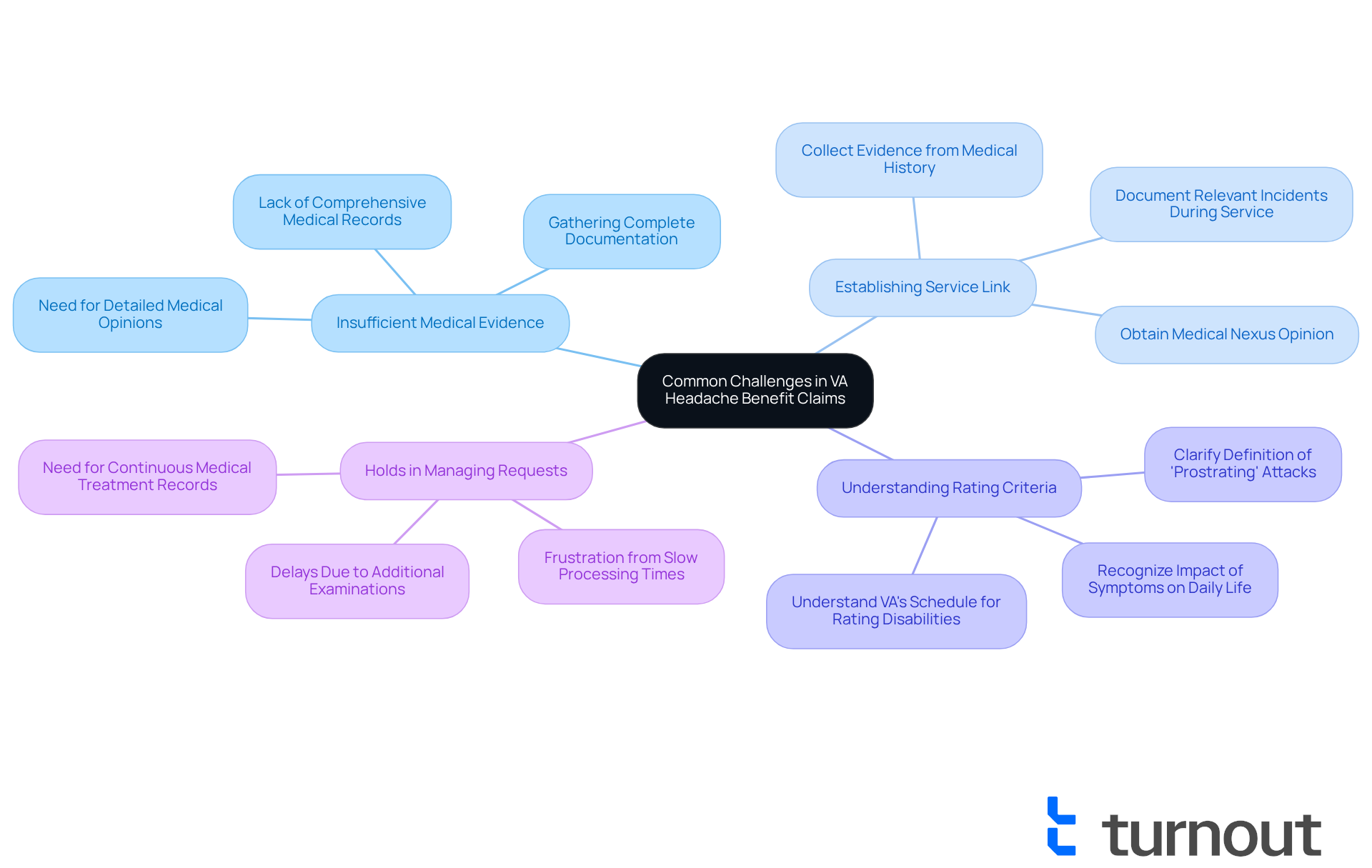
Navigating the Appeals Process for VA Headache Claims
If your VA headache claim has been denied, it's important to know that you have the right to contest this decision. We understand that this can be a challenging time, but there is a process in place to help you. Here are some critical steps to guide you through the appeals process:
- Review the denial letter carefully. Understanding the reasons for the denial is key to identifying what needs to be addressed.
- Gather additional evidence, such as medical records or buddy statements, to counter the issues raised in the denial.
- Submit a Notice of Disagreement (NOD) to formally initiate the appeal process.
- Consider seeking assistance from a consumer advocacy organization. They can provide valuable support and guidance to strengthen your appeal.
Comprehending this process is crucial for former service members like you to effectively advocate for your rights. Currently, approximately 333,000 appeals are pending, with around 75% resulting in benefits. This highlights not only the volume of appeals but also the potential for success.
As one experienced individual pointed out, "Receiving a VA decision that isn't what you hoped for can feel like a major setback." This illustrates the emotional impact of the appeals process. Typically, you can anticipate that the appeals procedure for pain-related requests may take several months, with some waiting more than a year for a decision. However, there are many instances of former service members successfully contesting VA decisions regarding headaches VA rating benefits. This shows that persistence and proper documentation can indeed lead to positive outcomes.
As another experienced individual shared, "It takes two to three years to get any claim approved. It's insane. It's horrid." This underscores the importance of remaining proactive and informed throughout your appeals journey. Remember, you are not alone in this process, and we're here to help you navigate it.
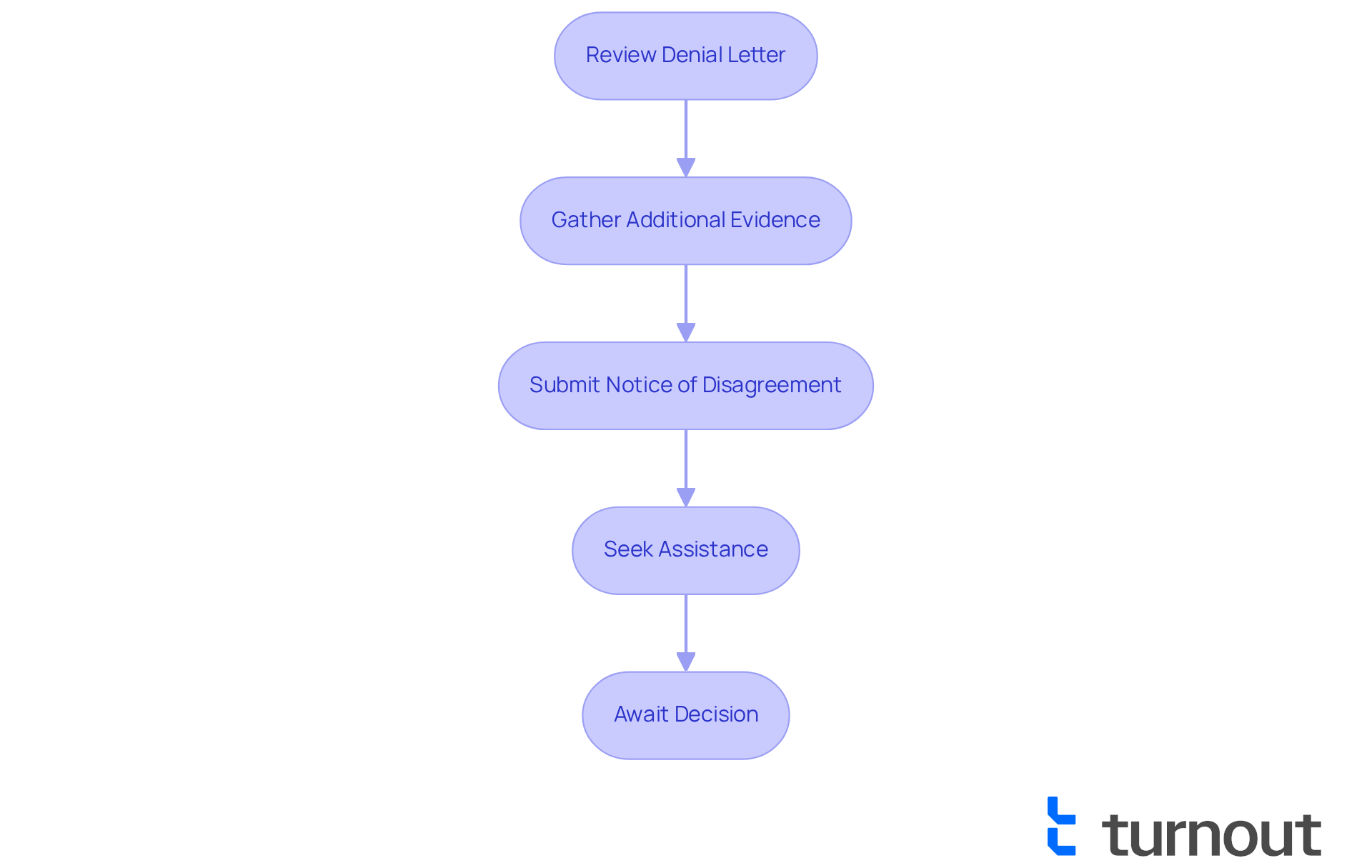
Resources for Veterans Seeking Headache Benefit Support
Veterans seeking support for headaches VA rating benefits face many challenges, and it's important to know that there are valuable resources available to assist them. Consider the following options:
- The VA's official website provides extensive information on benefits and requests related to headaches, including eligibility criteria and application procedures.
- Local support organizations for former military personnel offer tailored assistance with the application process. Engaging with these groups can significantly enhance your chances of success, as research shows that individuals who connect with them often achieve better results.
- Online forums and support groups allow veterans to share their experiences and advice, fostering a sense of community and mutual support.
- Turnout's support programs are designed to assist veterans in navigating the complexities of the application process. They offer personalized help, making it easier to access government benefits and financial aid. Trained non-lawyer advocates are available to guide clients through these processes.
Leveraging these resources can empower veterans to manage their applications more effectively. Many have found success through these support services. One veteran shared, 'The assistance I received made all the difference in my claim process.' By utilizing these tools, you can enhance your chances of receiving the benefits you deserve. Remember, you are not alone in this journey, and we are here to help.
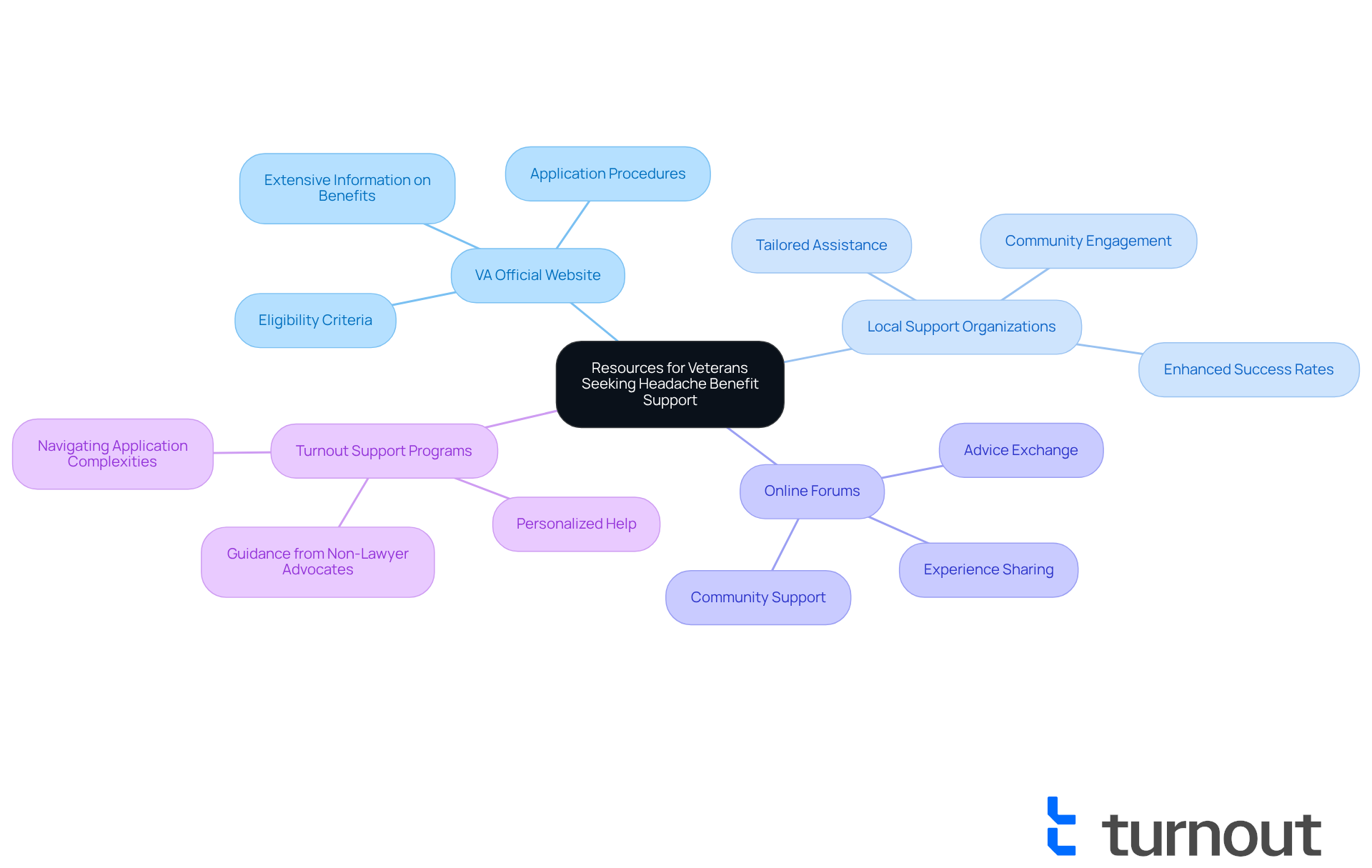
Conclusion
Navigating the complexities of the VA headache rating process can feel overwhelming for veterans. We understand that this journey is not easy, but grasping the essential insights outlined in this article can significantly ease the way forward. By leveraging technology, such as AI, to streamline applications, veterans can enhance their chances of receiving the benefits they deserve.
Key discussions have focused on:
- The various VA rating criteria for migraines and tension headaches
- The steps necessary to establish a service connection
- The importance of thorough documentation
- Insights into the evaluation of prostrating migraines
- Eligibility for Total Disability Individual Unemployability (TDIU)
These discussions highlight the critical role of detailed personal accounts and medical evidence in securing a favorable rating.
We encourage veterans to take proactive steps in their claims process. Gathering comprehensive medical records and seeking support from advocacy organizations can make a significant difference. The journey may be challenging, but with the right tools and assistance, you can successfully navigate the VA system and receive the benefits you rightfully deserve. Remember, you are not alone in this journey, and support is available. Taking advantage of these resources can truly change the outcome.
Frequently Asked Questions
What is Turnout and how does it assist veterans with VA headache rating applications?
Turnout is a platform that utilizes cutting-edge technology, including AI, to simplify the VA rating application process for former service members. It provides clear instructions on necessary paperwork and eligibility standards, helping users submit their requests efficiently and effectively.
How does AI technology impact the VA rating application process?
AI technology has significantly improved processing efficiency, resulting in a ninefold increase in speed. The average time to complete disability-related claims has decreased to just 94.8 days, making it easier for service members to access essential benefits.
What are the VA rating criteria for migraines and tension headaches?
The VA rating for migraines can be assessed at 0%, 10%, 30%, 50%, or 100%, depending on the frequency and severity of the attacks. Tension-related headaches are typically rated at 0% or 10%.
What steps should a veteran take to establish a service connection for headaches?
Veterans should collect thorough medical documentation detailing the frequency, intensity, and impact of their headaches, acquire records suggesting exposure to potential causes, and submit a personal statement explaining how their military service contributed to their condition.
What average ratings can veterans expect for migraines and what factors can influence a higher rating?
The average VA rating for migraines is typically 30%. However, veterans experiencing very frequent prostrating attacks that cause severe economic inadaptability may qualify for a 50% rating. Thorough documentation of symptoms and experiences is crucial for securing benefits.




